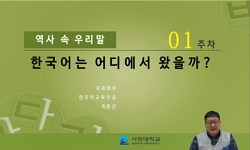Of the Hun-min-jeong-eum unused 14 letters, 11 letters are dental consonants. Dental consonants are exactly the letters which in both Chinese and Korean are unclear and both are found in a vague and different positions. The creation of the Korean lett...
http://chineseinput.net/에서 pinyin(병음)방식으로 중국어를 변환할 수 있습니다.
변환된 중국어를 복사하여 사용하시면 됩니다.
- 中文 을 입력하시려면 zhongwen을 입력하시고 space를누르시면됩니다.
- 北京 을 입력하시려면 beijing을 입력하시고 space를 누르시면 됩니다.
부가정보
다국어 초록 (Multilingual Abstract)
Of the Hun-min-jeong-eum unused 14 letters, 11 letters are dental consonants. Dental consonants are exactly the letters which in both Chinese and Korean are unclear and both are found in a vague and different positions. The creation of the Korean letters has a very strong connection to the way Chinese sounded like. Whether explained by the theory of Chinese phonetics or by corresponding pronunciation, Chinese serves as a very important basis and reference point with regards to initial Korean letters and Middle Korean. The main characteristic of this article is identifying the phonemes of both Korean and Chinese and organizing them according to their IPA equivalents, then facing them with Chinese equivalents, Mongolian and Japanese, thereby checking the issues concerning the sound value, palatalization, voicing etc. of these letters. The article examines dental fricatives, including dental head sounds ᅎ ᅔ ᅏ ᄼ ᄽ, and main dental sounds ᅐ ᅕ ᅑ ᄾ ᄿ Korean dental sounds ㅈ, ㅊ, ㅉ, ㅅ, ㅆ and semi-dental sound ㅿ, altogether four groups.
In the research method this article adopts an original approach assuming a pair of semi dental sounds: using the semi-dental-head-sound and the semi-main-dental-sound in order to speculate the position of the semi dental sound. Also, this article proposes the concept of semi-palatalization to explain the different stages of the Korean palatalization process and to explain ㅿ not only as a symbol of existence, but also of sound change.
In the conclusion, the article assumes that sound value of ㅿ is not /z/, but is between /z/ and /ʑ、ʐ/, namely /ʒ/.
참고문헌 (Reference)
1 金銓, "飜譯小學"
2 謝雲飛, "語音學大綱" 學生書局 1987
3 崔世珍, "訓蒙字會"
4 鄭承惠, "訓民正音과 日本語表記——以司譯院譯書為中心" 2009
5 李成九, "訓民正音研究" Apple企劃 1998
6 姜信沆, "訓民正音研究" 成均館大學校出版部 2003
7 陸孝昌, "訓民正音 規定의 齒音의 音價에 對하여" 在美韓國學校ㅏ議會 2012 (2012): 4-14, 2012
8 世宗大王, "訓民正音"
9 國立國語院, "訓民正音" 世界圖書出版公司 2008
10 董同龢, "漢語音韻學" 文史哲出版社 1989
1 金銓, "飜譯小學"
2 謝雲飛, "語音學大綱" 學生書局 1987
3 崔世珍, "訓蒙字會"
4 鄭承惠, "訓民正音과 日本語表記——以司譯院譯書為中心" 2009
5 李成九, "訓民正音研究" Apple企劃 1998
6 姜信沆, "訓民正音研究" 成均館大學校出版部 2003
7 陸孝昌, "訓民正音 規定의 齒音의 音價에 對하여" 在美韓國學校ㅏ議會 2012 (2012): 4-14, 2012
8 世宗大王, "訓民正音"
9 國立國語院, "訓民正音" 世界圖書出版公司 2008
10 董同龢, "漢語音韻學" 文史哲出版社 1989
11 王力, "漢語音韻" 中華書局 1963
12 宋憲奭, "漢語獨學"
13 朴在淵, "漢語會話書:10~30年代舊活字本9種" 學古房 2009
14 司譯院, "漢清文鑒"
15 申叔舟, "洪武正韻譯訓"
16 樂昭鳳, "洪武正韻"
17 信眉, "楞嚴經諺解"
18 申叔舟, "東國正韻"
19 權大連, "朴通事諺解"
20 韓國國史編纂委員會, "朝鮮王朝實錄" 韓國國史編纂委員會 1955
21 康遇聖, "捷解新語"
22 陳彭年, "廣韻"
23 國際語音學會, "國際語音學會手冊-國際音標使用指南" 上海教育出版社 2008
24 許雄, "國語音韻學" 正音社 1970
25 李基文, "國語音韻史硏究" 國語學會 1972
26 洪允杓, "國語史 時代區分의 問題點과 文法史의 側面에서 본 時代區分" 25 : 319-333, 1995
27 崔世珍, "四聲通解"
28 李新魁, "古音概說" 廣東人民出版社 1979
29 洪舜明, "倭語類解"
30 未詳, "伊D波"
31 崔(愛, "中國語音韻學" 통나무 2000
32 宋憲奭, "中國語自通"
33 高本漢, "中國聲韻學大綱, 張洪年譯" 中華叢書會 1972
34 李新魁, "中古音" 商務印書館 1991
35 崔世和, "中世國語의 破擦音攷 : 口蓋音化와 關聯하여" 79/80 : 99-117, 1979
36 陸孝昌, "中世國語 ㅅ의 音價에 對한 考察" 8 : 175-194, 1996
37 李方桂, "上古音硏究" 商務印書館 1980
38 李洙等, "A乞大諺解"
동일학술지(권/호) 다른 논문
-
‘(是)……的’구문의 통사ㆍ의미와 한국어 대응관계를 통한 교육방안
- 한국중국언어문화연구회
- 이은경
- 2015
- KCI등재
-
- 한국중국언어문화연구회
- 정겨울
- 2015
- KCI등재
-
乡村生态的文化理想写意 - “边地”与“商州”的诗意书写与现实写意
- 한국중국언어문화연구회
- 주릉
- 2015
- KCI등재
-
- 한국중국언어문화연구회
- 郭圣林
- 2015
- KCI등재
분석정보
인용정보 인용지수 설명보기
학술지 이력
| 연월일 | 이력구분 | 이력상세 | 등재구분 |
|---|---|---|---|
| 2023 | 평가예정 | 재인증평가 신청대상 (재인증) | |
| 2020-01-01 | 평가 | 등재학술지 선정 (재인증) |  |
| 2018-01-01 | 평가 | 등재후보학술지 선정 (신규평가) |  |
| 2017-12-01 | 평가 | 등재후보 탈락 (계속평가) | |
| 2016-12-01 | 평가 | 등재후보로 하락 (계속평가) |  |
| 2013-04-03 | 학회명변경 | 한글명 : 한국현대중국연구회 -> 한국중국언어문화연구회영문명 : Korea Research Center For China -> Korean Society of Study on Chinese Languge and Culture |  |
| 2013-04-03 | 학술지명변경 | 한글명 : 韓中言語文化硏究 -> 한중언어문화연구 |  |
| 2012-01-01 | 평가 | 등재학술지 선정 (등재후보2차) |  |
| 2011-01-01 | 평가 | 등재후보 1차 PASS (등재후보1차) |  |
| 2010-01-01 | 평가 | 등재후보학술지 유지 (등재후보2차) |  |
| 2009-01-01 | 평가 | 등재후보 1차 PASS (등재후보1차) |  |
| 2008-01-01 | 평가 | 등재후보학술지 유지 (등재후보1차) |  |
| 2006-01-01 | 평가 | 등재후보학술지 선정 (신규평가) |  |
학술지 인용정보
| 기준연도 | WOS-KCI 통합IF(2년) | KCIF(2년) | KCIF(3년) |
|---|---|---|---|
| 2016 | 0.06 | 0.06 | 0.05 |
| KCIF(4년) | KCIF(5년) | 중심성지수(3년) | 즉시성지수 |
| 0.04 | 0.03 | 0.199 | 0.02 |




 KCI
KCI



